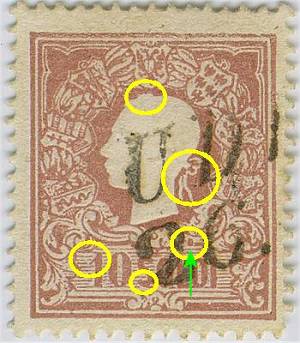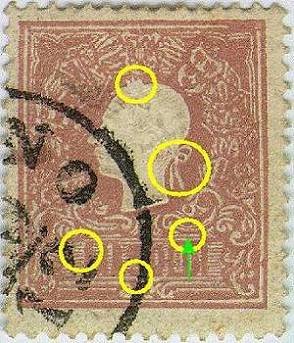 |
 |
|
|
Fig. 1: first type |
Fig. 2: second type |
The main differences are:
10 SOLDI
Also for this stamp it is not difficult to distinguish the two types; as always I show here below two samples, one for the first type (Fig. 1) and one for the second one (Fig. 2).
 |
 |
|
|
Fig. 1: first type |
Fig. 2: second type |
In
the first type the curl on top of the nape is flat and low, very often
not so evident (common characteristic of all the values of the first
type). In the second type the curl is bigger and pointed up (common
characteristics of all the values of the second type). |
In
the first type the ribbon beyond the nape is open, similar to a "3"
and it's thin (common characteristics of all the values of the first
type). In the second one it's closed, similar to an "8" and
thicker (common characteristic of all the values of the second type).. |
In
the first type it's very visible a color dot in the ornament, on top
of the letters "LD" of "SOLDI". |
In
the first type the diagonal trait of the number "1" is well
visible; it's practical absent in the second type. |
In
the first type the bottom line under the "S" of "SOLDI"
in interrupted, while in the second one is continuous. |
It should be mentioned that other small details that differentiate the two types do exist, but they are quite difficult to be found (any suggestion? Just check the King profile...). I invite you to go to the specialist material to find more info.
Catalogued color shades (as per Sassone) - 1st type
Brown (typical color)
Pale brown
Dark brown
Catalogued color shades (as per Sassone) - 2st type
Brown (typical color)
Pale brown